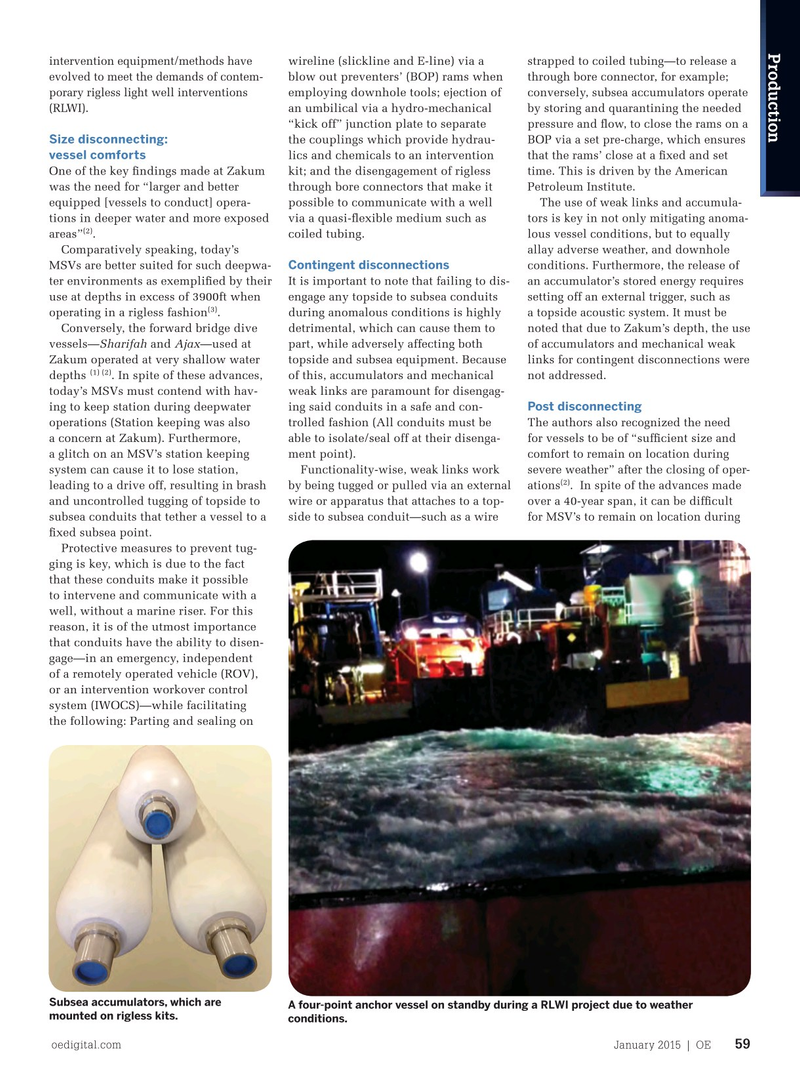
Page 57: of Offshore Engineer Magazine (Jan/Feb 2015)
Read this page in Pdf, Flash or Html5 edition of Jan/Feb 2015 Offshore Engineer Magazine
EyebrowProduction wireline (slickline and E-line) via a intervention equipment/methods have strapped to coiled tubing—to release a blow out preventers’ (BOP) rams when through bore connector, for example; evolved to meet the demands of contem- employing downhole tools; ejection of porary rigless light well interventions conversely, subsea accumulators operate an umbilical via a hydro-mechanical by storing and quarantining the needed (RLWI). “kick off” junction plate to separate pressure and fow, to close the rams on a
Size disconnecting: the couplings which provide hydrau-
BOP via a set pre-charge, which ensures vessel comforts lics and chemicals to an intervention that the rams’ close at a fxed and set
One of the key fndings made at Zakum kit; and the disengagement of rigless time. This is driven by the American was the need for “larger and better through bore connectors that make it
Petroleum Institute.
equipped [vessels to conduct] opera- possible to communicate with a well
The use of weak links and accumula- tions in deeper water and more exposed via a quasi-fexible medium such as tors is key in not only mitigating anoma- (2) areas” . coiled tubing.
lous vessel conditions, but to equally Comparatively speaking, today’s allay adverse weather, and downhole
Contingent disconnections
MSVs are better suited for such deepwa- conditions. Furthermore, the release of ter environments as exemplifed by their It is important to note that failing to dis- an accumulator’s stored energy requires use at depths in excess of 3900ft when engage any topside to subsea conduits setting off an external trigger, such as (3) operating in a rigless fashion . during anomalous conditions is highly a topside acoustic system. It must be Conversely, the forward bridge dive detrimental, which can cause them to noted that due to Zakum’s depth, the use vessels—Sharifah and Ajax—used at part, while adversely affecting both of accumulators and mechanical weak
Zakum operated at very shallow water topside and subsea equipment. Because links for contingent disconnections were (1) (2) depths . In spite of these advances, of this, accumulators and mechanical not addressed.
today’s MSVs must contend with hav- weak links are paramount for disengag-
Post disconnecting ing to keep station during deepwater ing said conduits in a safe and con-
The authors also recognized the need operations (Station keeping was also trolled fashion (All conduits must be for vessels to be of “suffcient size and a concern at Zakum). Furthermore, able to isolate/seal off at their disenga- comfort to remain on location during a glitch on an MSV’s station keeping ment point).
Functionality-wise, weak links work severe weather” after the closing of oper- system can cause it to lose station, (2) by being tugged or pulled via an external ations . In spite of the advances made leading to a drive off, resulting in brash wire or apparatus that attaches to a top- over a 40-year span, it can be diffcult and uncontrolled tugging of topside to side to subsea conduit—such as a wire for MSV’s to remain on location during subsea conduits that tether a vessel to a fxed subsea point.
Protective measures to prevent tug- ging is key, which is due to the fact that these conduits make it possible to intervene and communicate with a well, without a marine riser. For this reason, it is of the utmost importance approach to show where the aforemen- that conduits have the ability to disen- tioned technologies presently stand. A gage—in an emergency, independent similar approach will equally be used in of a remotely operated vehicle (ROV), or an intervention workover control this follow up article to demonstrate—in system (IWOCS)—while facilitating greater detail—how today’s multi-service vessels (MSV), and subsea and rigless the following: Parting and sealing on
Subsea accumulators, which are
A four-point anchor vessel on standby during a RLWI project due to weather
Coiled tubing running through a vessel’s moonpool. mounted on rigless kits. conditions. oedigital.com January 2015 | OE 59 058_OE0115_ProdOps1.indd 59 12/22/14 4:51 PM

 56
56

 58
58